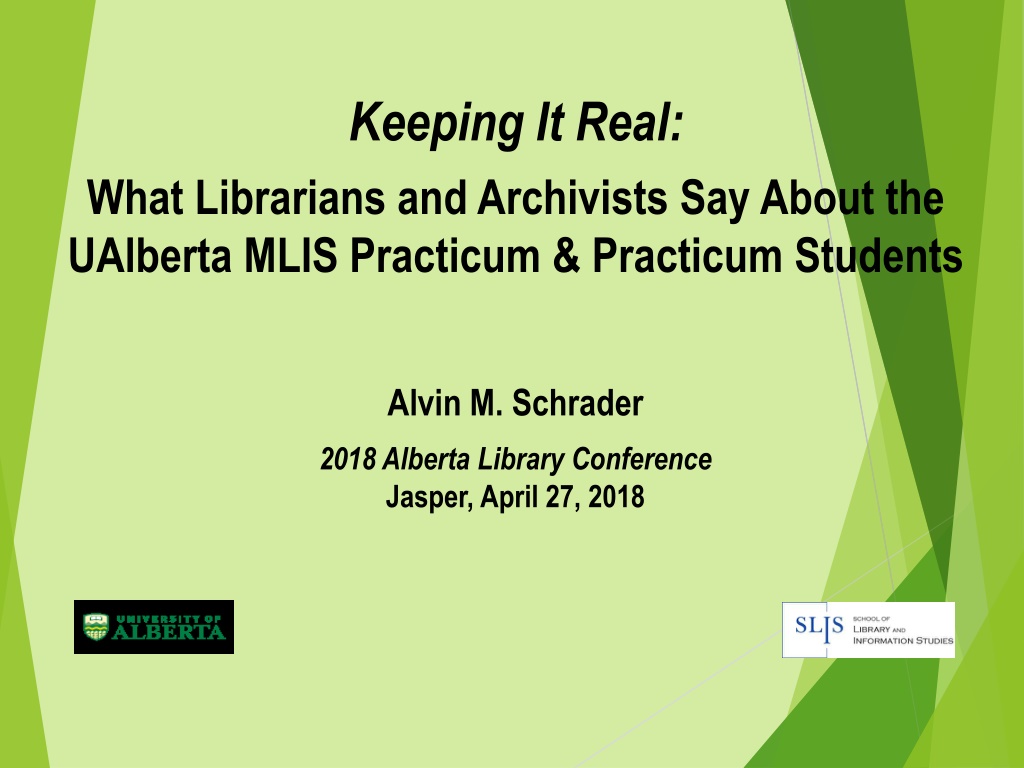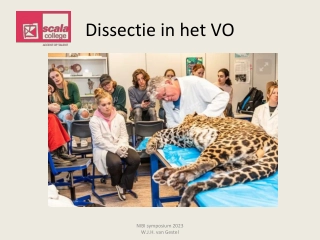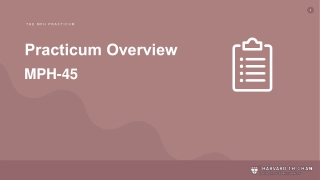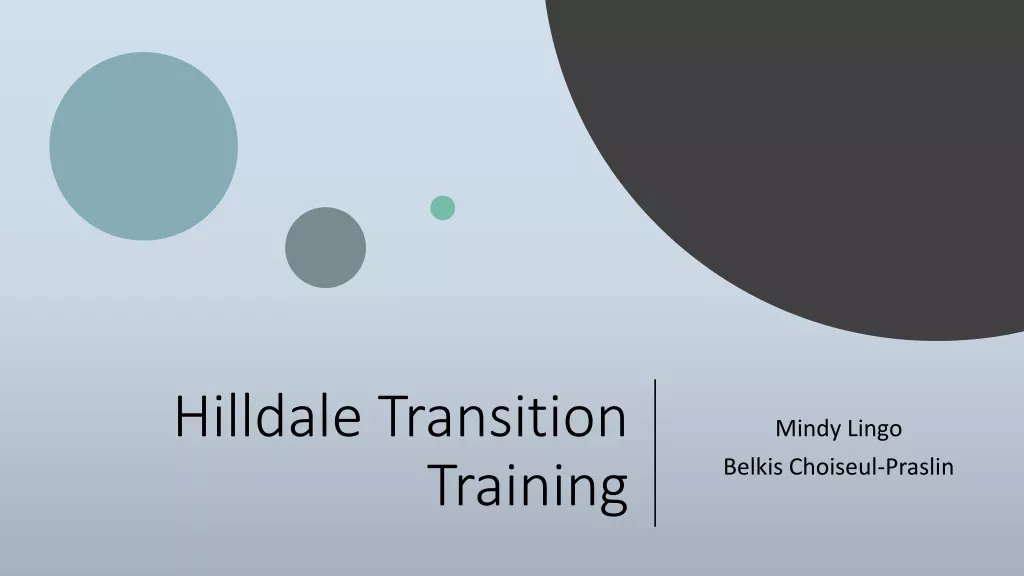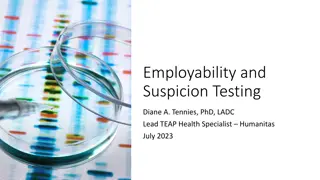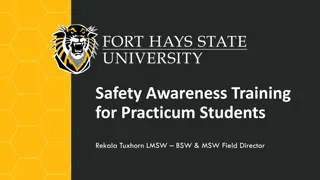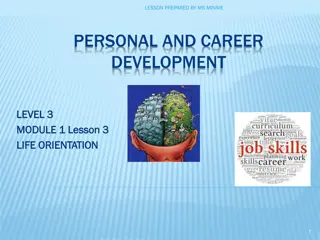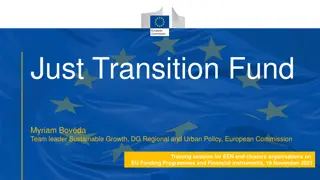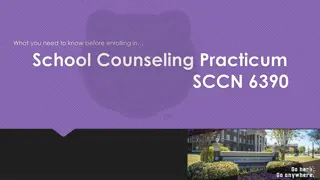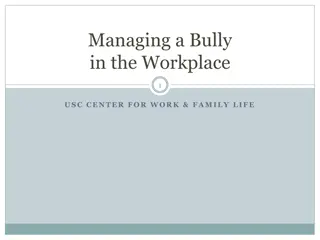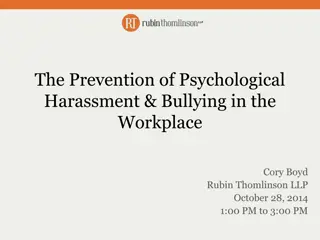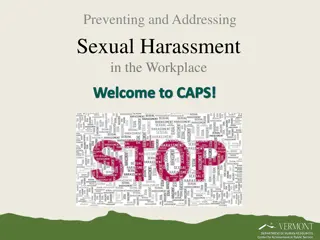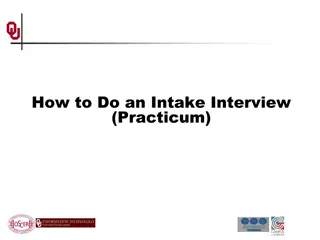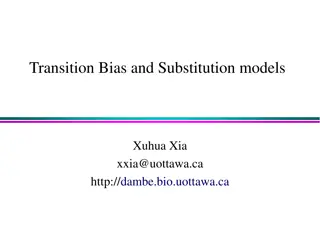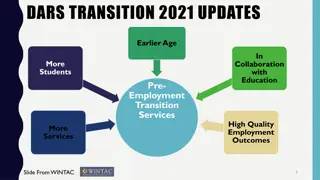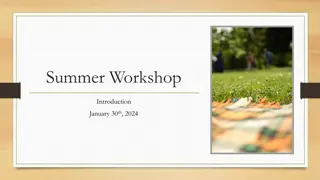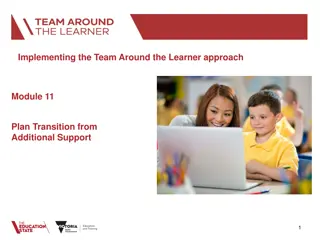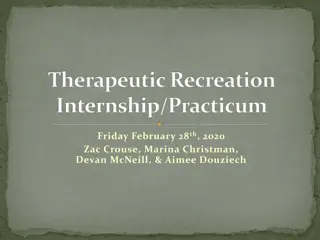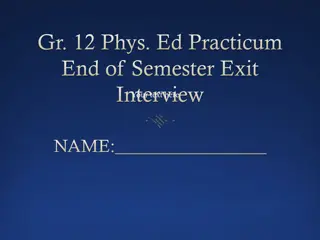Insights into MLIS Practicum and Workplace Transition
Librarians and archivists share perspectives on the UAlberta MLIS Practicum, focusing on self-leadership, transition intensities, student sentiments, and cultural differences between classroom and workplace environments. The discussions cover key aspects such as self-awareness, teamwork, emotional intelligence, and holistic performance appraisal, offering valuable insights for students entering the professional field.
Download Presentation

Please find below an Image/Link to download the presentation.
The content on the website is provided AS IS for your information and personal use only. It may not be sold, licensed, or shared on other websites without obtaining consent from the author.If you encounter any issues during the download, it is possible that the publisher has removed the file from their server.
You are allowed to download the files provided on this website for personal or commercial use, subject to the condition that they are used lawfully. All files are the property of their respective owners.
The content on the website is provided AS IS for your information and personal use only. It may not be sold, licensed, or shared on other websites without obtaining consent from the author.
E N D
Presentation Transcript
Keeping It Real: What Librarians and Archivists Say About the UAlberta MLIS Practicum & Practicum Students Alvin M. Schrader 2018 Alberta Library Conference Jasper, April 27, 2018
The Indivisible Prism of Self-leadership self-awareness, self-reflection, self-evaluation, self- understanding self-direction, self-motivation, self-management self-presentation and public speaking empathic listening and interpersonal communication relationship-building and networking teamwork and collaboration change management and dispute resolution reading organizational culture and dynamics sensing and absorbing tacit knowledge about workplace vision and values, mission, priorities, hierarchy, interpersonal relationships, influence networks, teamwork, planning, and decision-making ethical and principled character, authenticity, integrity, passion, commitment
Intensities of Transition Endings Beginnings depression resignation letting go sadness anxiety overwhelmed frustration forward-looking anticipation confusion resistance optimism
What students said, in a word, about starting their Practicum: excited excited! really excited excitement! excited and nervous excited but a little bit nervous settled and excited anxious! anxiousipation anticipation filled with anticipation energized enthusiastic inspired gratitude! looking forward a great opportunity! thrilled thrilled! optimistic! very positive I can't wait to start! eager curious and very eager exceptionally eager nervous nervous! jittery jittery! a bit uncertain a little bit nervous I think we ll be coming out with some great experiences
Differences between the Cultures of Classroom and Workplace ~ hierarchy ~ social complexity ~ relationship management ~ tacit knowledge, tacit learning ~ verbal communication ~ supervisory relationship ~ emotional intelligence ~ collaboration and teamwork ~ workflow ~ service delivery ~ holistic performance appraisal ~ multiple roles ~ decision-making ~ supervision, delegation ~ organizational alignment ~ personal initiative, engagement ~ lifelong learning ~ lexicon of organizational culture ~ payment for time and services
The UAlberta MLIS Leadership Practicum Pedagogy Focus and Approach A leadership experience within a framework of action-centred self-leadership and professional socialization for meaningful personal growth
Full-time Practicum Cycle 100 hours in 15 days* Week 1 days 1-3 day 5 check-in forum all students: How are you feeling? journal of activities and feelings each student Week 2 days 6-8 days 8-10 day 10 check-in forum all students: Pleasant surprises? How have relationships changed? mid-point check-in with each supervisor (Alvin) journal each student Week 3 days 11-13 check-in forum all students: Employer orientation plan? Self-orientation tips for new staff? day 15 reflective paper each student day 15 exit interview and signed form each student & supervisor * The part-time Practicum cycle is 100 hours distributed over 10-13 weeks
Key Survey Questions for Practicum Supervisors about the UAlberta MLIS Practicum ~ Was their student prepared for the placement? ~ Would they provide a job reference for the student? ~ Did they endorse the School s approach to the Practicum as a leadership experience? ~ What benefits were gained in supervising a Practicum student?
Key Survey Findings Practicum Supervisors Perceptions ~ students were well prepared for their placements ~ students merited positive job references ~ Supervisors endorsed the School s approach to the Practicum as a leadership experience
Key Survey Findings Multiple Mutual Benefits of Supervising a Practicum institutional undertaking library projects and activities first-hand look at a potential new staff member professional bringing a different perspective, with fresh eyes gaining new knowledge, sharing knowledge, staying connected helping and mentoring new professionals giving back to the profession, especially SLIS building supervisory and mentoring aspects of my CV developing team skills making lasting professional connections
References Alvin M. Schrader (2008). Hitchhiking across Cultures from the Classroom to the Workplace. Feliciter 54(2):43-46. Alvin M. Schrader [with a journal contribution by Anwen Burk] (2012). "School to Work Transitions: Hitchhiking Across Cultures." In: The Future is Now: Responses to the 8Rs Canadian Library Human Resources Study. Eds. Kathleen De Long and Allison Sivak (Canadian Library Association, Ottawa, Ont.):4-28. Available at URLhttp://www.ls.ualberta.ca/8rs/8rs-future-is%20now.pdf Alvin M. Schrader (2017). Survey of Practicum Supervisors in the MLIS Program, 2015-2017. Available at URL https://cloudfront.ualberta.ca/- /media/education/slis/documents/accreditation/supervisor-survey-2015- 2017.pdf University of Alberta Practicum. LIS 590: Practicum On-campus and Online. Available at URL https://www.ualberta.ca/school-of-library- and-information-studies/courses/on-campus-graduate-courses/lis-590- outline
Additional References American Library Association (2009). Core Competences of Librarianship. Available at http://www.ala.org/educationcareers/sites/ala.org.educationcareers/files/content/careers/coreco mp/corecompetences/finalcorecompstat09.pdf Lopatovska, Irene, and Hilary Baribeau (2017). What Information Professionals Need to Know: Job Ads Analysis. Proceedings of the Association for Information Science and Technology, Washington, DC, 2017, pp. 747-749. Available at https://onlinelibrary.wiley.com/doi/abs/10.1002/pra2.2017.14505401141 Moran, Barbara B., Claudia J. Morner, and Robert. D. Stueart (2018). Library and Information Center Management. Libraries Unlimited, Santa Barbara, CA., 9th ed. Northouse, Peter G. (2007). Leadership: Theory and Practice.SAGE Publications, Thousand Oaks, CA, 4th ed. Oud, Joanne (2005). "Jumping into the Deep End: Training for New Academic Librarians." Feliciter 51(2):86-88. Available at http://login.ezproxy.library.ualberta.ca/login?url=http://search.ebscohost.com/login.aspx?direct =true&db=rch&AN=16971909&site=eds-live&scope=site Oud, Joanne (2008). Adjusting to the Workplace: Transitions Faced by New Academic Librarians. College & Research Libraries 69.3:252-267. Available at http://crl.acrl.org/content/69/3/252.full.pdf+html Samier, Eugenie (2005). Toward Public Administration as a Humanities Discipline: A Humanistic Manifesto. Halduskultuur [Administrative culture] 6:6-59. Samier, Eugenie (2005). Toward a Weberian Public Administration: The Infinite Web of History, Values, and Authority in Administrative Mentalities. Halduskultuur [Administrative culture] 6:60-93. Special Libraries Association. (2016). Competencies for Information Professionals. Available at https://www.sla.org/about-sla/competencies/
